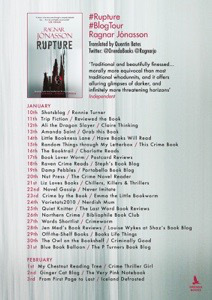Edward Hancox's Blog
June 18, 2023
Sigur Rós & London Contemporary Orchestra
16th June 2023 – Royal Festival Hall, Southbank Centre, London.

Sigur Rós start with the brand new Blóðberg, named after a bright pink flower that emerges from the cold, dark Icelandic winter each spring. There’s some similarities with the rock flower too, with Sigur Rós emerging on to a dark stage, filled with the patiently waiting London Contemporary Orchestra dressed in black and wisps of Fischersund incense. The band are dotted through the orchestra, letting the music take pride let of place. It’s a stunning start, even if I can only just see Jonsí.

The performance is part of the Meltdown festival, curated by Christine and the Queens, but this is a big day for Sigur Rós marking the start of their tour, and the release of their first album for a decade. Up the road at Kings Cross, a listening party is underway for Átta, and electronic billboards are displaying the album cover across the city.
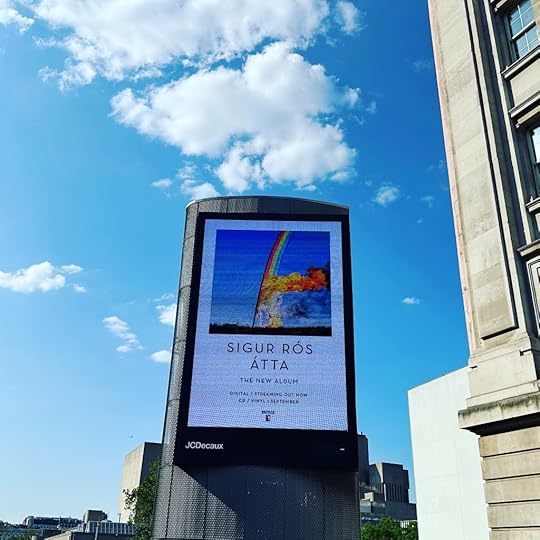
Older friends arrive in the form of Ekki múkk and Fljótavík, but it’s the emotion stirring Andvari that really captures the audience, who have until now, kept participation to polite applause. Starálfur remains a thing of beauty, forever associated with the sighting of the Jaguar shark in Wes Anderson’s The Life Aquatic. The delicious Dauðalogn follows, before the band leave us with the orchestra to deliver the nearly forgotten Varðeldur.
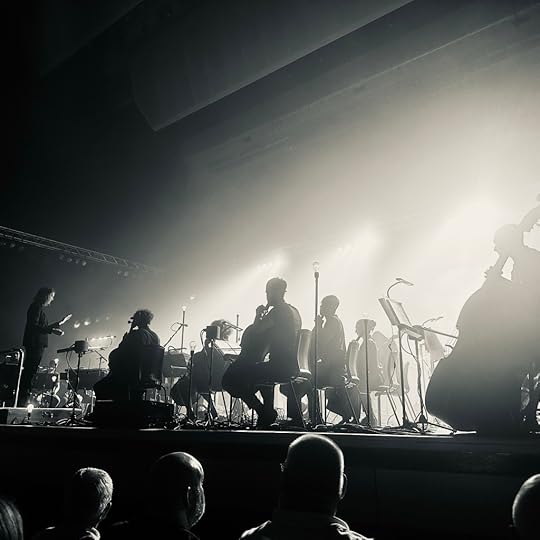
After an over priced drink or two at the bar, the band return with Vaka, although a restart is required at the request of Jonsí. It’s not the first time tonight, and a reminder that we’re the first stop on a world tour, and after all, practice does make perfect. There’s a bit of a slump in the second half with neither Ylur or Skel being well enough known to match the weight of expectation – the new album was released only 21 hours previously – and All Alright being particularly introspective. I notice the guy next to me has fallen fast asleep, snoring gently.

We needn’t have worried though. A couple of gifts from Takk are just around the corner. Sé Lest injects some energy with its tinkling refrains and honking brass, whilst the sound of hundreds of wedding ceremonies and BBC nature documentaries, Hoppípolla, is reinserted into the set list after being missing in action for several years. It’s much appreciated by the audience.
There’s some disappointment that Popplagið doesn’t make its traditional appearance to close proceedings; instead the orchestra deliver a forbidding Avalon for us. The band return to bow to the audience, alongside conductor Robert Ames. It’s been a magical night. The standing ovation is fully deserved, and my new seat mate is now fully awake.

June 1, 2023
Happy 10th Anniversary to Iceland, Defrosted.
It’s hard to believe that it’s been a decade since my first book was published. I’m not sure of the etiquette. Cakes? fireworks? Say nothing?
It was due for release on 17th June 2013, on Icelandic National Day but Jeff Bezos and his corporate crew decided that 1st June would be good enough. Best laid plans and þetta reddast.
Iceland, Defrosted has friendship and patience at its heart; over a beer, my good friend Einar suggested that it would be a good idea to capture my obsession with Iceland in writing and that itself is a very Icelandic thing to do, with – top fact! – 1 in 10 Icelanders being published authors. From Llandudno to Snæfellsnes, rotten shark tasting to Airwaves, none of it would been possible without Einar.
During 6 years of ‘research’ trips to Iceland involving puffins, Arctic fox and the northern lights, and often a very patient wife, to a crowd-funding appeal that thankfully took off with friends (and friends of friends), a determined Rough Guides editor, an encouraging publisher in Silverwood, Icelandic language checking from Eygló at Iceland Review, and an ever evolving cast of supportive Icelanders, Iceland, Defrosted was born.
From there it took on a life of its own. It’s launch at the Icelandic Embassy in London with the very talented Irís sold out (the first and last time, I’ll sell out a venue, surely?!), the lovely Anna at Wenlock Books couldn’t do enough to help, causing frequent deliveries of more copies, Andy at Left For Dead helped by both hosting an in-store with Hafdís Huld, and even signing copies himself (well, he is in it…). There was more madness too; glowing reviews from National Geographic and Wanderlust, a hardback version, and for reasons that I’ve forgotten, a single copy smaller than a one Krona coin.
In 2022, nine years after being released into the wild, I received a tweet from a stranger to tell me that he’d found a copy in a bookshop in Flateyri, probably the remotest bookshop Iceland, if not the world. I was thrilled. Iceland, Defrosted had made it home.
The success of Iceland, Defrosted has been a constant and very lovely surprise. I’m hugely grateful for the messages, photos and reviews (or most of!). A sincere thank you to everyone who supported this daft book over the past decade. It’s sold thousands of copies worldwide, and continues to sell. Not enough to make me rich (thanks again Jeff Bezos, no really, you shouldn’t have), but enough for return airfares to Iceland and Sigur Rós tickets. Better than that, it’s a reminder of the power of friendship, a love letter to everything Icelandic, and a lasting legacy to leave behind. Takk.

November 28, 2022
Sigur Rós & Northern Lights
The northern lights dance across the Reykjavík sky and frost crunches underfoot as a line of people rub their hands together and stamp their feet. They are waiting to see Sigur Rós.
As is now just as customary as finishing each set with Popplagið, Sigur Rós are finishing their world tour with a home coming to Reykjavík. As always, the tour has been met with critical acclaim across the globe. There has been something different this time round though. Perhaps it’s the recent struggles with Icelandic tax authorities, the unanticipated change in line up or the impact of the pandemic, but Sigur Rós are tighter, sharper and considerably less whimsical than ever before. A ready sense of humour is present though; merchandise for the show has had the word ‘Takk’ replaced with ‘Tax’.

At Laugardalshöll, we are treated to a return of Amiina with their strings and Brassgat í bala with, well, brass for the first time in fourteen years. It’s a shame then, that Laugardalshöll isn’t the best venue, largely vacuous and with all the acoustics of a fish warehouse.
The first half is perhaps more introspective with a starting trio reliant on ( ), which is unsurprising considering the album’s recent twentieth birthday. The lighting and visuals are stunning, with Vaka accompanied by a laser etched skull in terrifying red. Svefn-f-englar and Ny Batteri return like old friends before the only new piece of the evening in Gold 2. Let’s hope this is a sign of new material to come. Heysátan is an early delight, with Brassgat í bala huddled around the band, bringing a tenderness all of its own. We’re left with the gentle refrain of Smáskifa, whilst in the back ground, a telephone wire is home to a flock of restless silhouette birds.

Doing away with a support act, perhaps to prevent any interference with the surgically precisioned stage set up, Sigur Rós present themselves in two acts with a civilised intermission at the halfway point. There’s no banter with the crowd either; Jonsí only once speaks to thank the audience for coming. No matter, the band provide warmth in a different way.
They return with Glósóli from the album Takk, with its pounding drums. Sæglópur is an absolute highlight, despite the sad meaning and visuals of a child being lost at sea. We’re treated to Gong and a poignant Andvari from Takk too. If worried that Amiina had added little to the first half, it was here that the girls made themselves heard, with Andavri leaving most of the crowd wiping their eyes.

The euphoric Festival was surely written to be a festival crowd pleaser, and there’s a lovely added surprise with a reprise from local school brass band performed from a balcony high above the audience. It’s the sort of heart-rending, spontaneous event that could only happen in Iceland.
We’re straight back to it though. Kveikur is a show of force, leaving anyone that just came for wedding soundtrack favourite Hoppípolla perhaps thinking they’d seen the wrong band. Traditional closer Popplagið – ironically translated as ‘pop song’ – leaves no room for doubt. With Amiina and Brassgat í bala adding their weight, Popplagið climaxes with such intensity that the crowd are enveloped in a wall of sound, only to be left with reverb ringing in their ears as the band leaves the stage. They return briefly to take a bow, beneath a banner that reads only ‘Takk’. Takk indeed, Sigur Rós.
May 14, 2022
Puffins of Føroyar
I asked the young woman in the tourist information centre in Klaksvík where the best place in the Faroe Islands is to see puffins. ‘Iceland’ comes the reply with a ready smile.
 Faroese puffin
Faroese puffin
The Faroe Islands are Danish territory, but fiercely independent in everything else. They sit in the cold Atlantic between Iceland and Shetland, somehow with shared elements of both, and yet nothing like either at the same time. The language shares it origins with old Norse, and the sheep trodden landscapes can look disarmingly similar. Then you see the under-sea roundabouts, helicopter buses, James Bond’s tombstone and the strange food combinations. I’m eating a cheese, bacon and coronation chicken sandwich as I type.
It’s the puffins that have bought me to Faroe Islands, a trip that’s been delayed twice due to the Covid-19 pandemic on a ticket bought in the Atlantic Airways flight sale in January 2020. Atlantic Airways are the islands’ tiny airline, with a total of just three planes. I caught the flight from Edinburgh with glee, only a one hour hop to Vágar. The airport here was built by the British in the Second World War; they also imported a love of Cadbury’s chocolate and fish and chips (Fisk og kips signs are everywhere).
 Faroe Islands roughly translates as ‘Sheep Islands’
Faroe Islands roughly translates as ‘Sheep Islands’
I base myself at Sørvágur, although I spent some time island hopping using the undersea tunnels and ferries. Kalsoy is a favourite; a long, thin island in the north, it’s effectively known as the flute due to the number of road tunnels drilled through it. The capital, Tórshavn, on Streymoy is decidedly underwhelming and has nothing on the buzz of Reykjavík. In the north of Streymoy is Saksun, a tiny village of turf houses above a stunning fjord. Local farmers are waging a war against trespassing instagrammers and drone users.
 The village of Saksun
The village of Saksun
It Mykines that catches my heart though. The most westerly of the Faroes, it’s actually two islands, with Mykineshólmur only adjoined by a short bridge and adorned with the lighthouse whose image has become shorthand for stunning Faroese landscapes. I caught the ferry a day late the harbour at Sørvágur, the first being cancelled due to a fierce swell. Faroe Islands are not nicknamed ‘the land of maybes’ for nothing, and it’s better to be captive at Sørvágur than Mykines without sufficient supplies. An eider duck in the harbour seemingly agrees with me, hooting as he passed.
 Mykineshólmur
Mykineshólmur
The ferry took us past the sea arch of Drangarnir and the imposing Tindhólmur a jagged, sharp tolberone triangle dropped into the sea. A set piece straight from Mordor. Apple have yet to produce a phone that captures such imposing .
Mykines slowly came into view, taller than I expected, with pronounced striations of rock and vivid green slopes, with brave Faroese sheep defiying gravity to find the freshest grass. The harbour is at the western end, and I had to jump ashore whilst the captain did battle in keeping the boat still. The boat sailed away with the Faroese flag flapping in the wind. Kittiwakes lined the harbour walls, loudly shouting their welcomes at us.
 Tindhólmur as seen from Bøur
Tindhólmur as seen from Bøur
At the top of the harbour path, arrivals are charged a ‘hiking fee’. A common charge in the Faroes, they go towards upkeep of paths and amenities. I have no problem paying it, and then turn left up a steep grassed slope to an area known as Lambi. It’s my first sight of puffins this year, and I’m heart jumps. There are hundreds of them, all freshly ashore. They are getting on with business; I can hear and see couples greeting each other by ‘billing’ and I even witness a puffin fight, with two puffins so engrossed in beating the other, they roll down the grass slope whilst scratching and biting at their foe, whilst moaning their dissatisfaction. Others are mainly preening and looking out to sea; a breather before eggs and chicks become a full time occupation.
 Puffin overlooking Mykines
Puffin overlooking Mykines
The path to the lighthouse is closed this year, ostensibly due to landslides but I suspect to further protect the puffin colony which is struggling, despite what I can see. A yellow sign and a green wire fence prevents any further access and I have to suffice with the stinking views. I should add that the weather is uncharacteristically clear, with the sun beating down, making the grass even greener and reflecting in the bright blue sea. I regret not bringing a hat, and the puffins seem to be enjoying the warmth on their backs too.
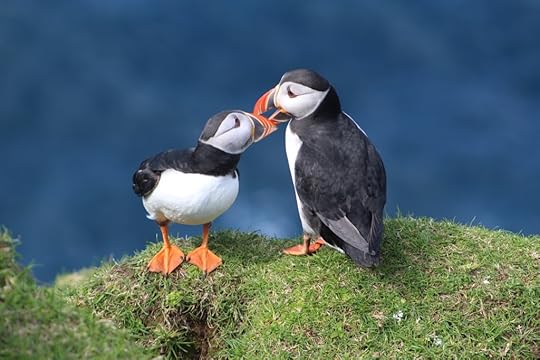
I settled down at Lambi to watch the puffins for a while, emerging from burrows and landing haphazardly, skills to be renewed after months at sea. I enjoyed seeing the small village below me, complete with helicopter landing pad.
After a wander around most of the island, simultaneously admiring the stunning views and avoiding sheep poo, I found myself in the village eating well-earned, homemade fish soup and crusty bread. The houses have turf roofs, and are mainly painted smart black, with a small stream meandering it’s way through. Most houses have a gannet or puffin adorned to them. A stone angel looks out to sea, watching over those brave souls who go out to find fish.
 Houses in Mykines
Houses in Mykines
Back on Vágar, I finished my trip at Gásadalur, a village that was all but cut off from the rest of the world until 2004 when a tunnel was burrowed through the rock. It’s famed for its plunging waterfall right into the sea, which is hard to beat, particularly with the sun setting behind. As the pink light waned, I noticed white spots at the top of the falls. Crossing the small bridge for further inspection, I was thrilled to find a small colony of puffins had moved in. Ten or so were stood sentry outside their burrows, as the falls thundered below them. I manage to take a few snaps without disturbing them, as the sun dips below the surface of the sea for another day.
The tourist information centre in Klaksvík are talking out of their hat. Puffins are alive and well in the Faroe Islands. Let’s hope it stays that way.
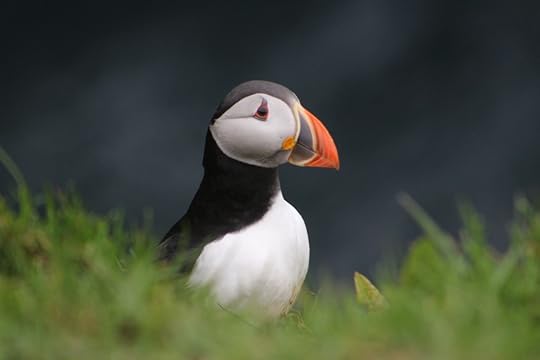

August 21, 2021
Every Last Puffin released on September 10th!

Really pleased to announce that Every Last Puffin will be released in paperback and ebook on September 10th.
More details, and preorders here: https://linktr.ee/everylastpuffin
June 1, 2020
Last few hours for Every Last Puffin
The crowd funding campaign for my second book, Every Last Puffin, finishes in the next 15 hours. If you enjoyed Iceland, Defrosted please have a look at my kickstarter campaign. There’s still just about chance to get involved in this special project, and your support will get you a Puffin pin badge, signed or dedicated copies or even a chance to spot Puffins with me!
Thank you. Your support is much appreciated as ever!
Ed.
https://www.kickstarter.com/projects/1978797490/every-last-puffin
[image error]
May 16, 2020
Puffin Rescue
The attached images are from a Puffin rescued in Anglesey, North Wales a couple of years back. It’s thought the puffin had been caught by a dog, and had received injuries to its wings as a result. Unbelievably, a member of the public had found him and was trying to feed him chips in an attempt to revive him. Puffins don’t eat chips, not even with ketchup.
The puffin was taken to RSPCA Stapely Grange in Cheshire where the staff did a fantastic job in nursing the puffin back to full health.
RSPCA staff released the puffin on a shale beach near to where he was found. They were good enough to send me a photo of him stood on the beach, looking out apprehensively. They tell me that the last they saw of him was heading out to sea. All we can hope is that after the hard work of the RSPCA team, and the fighting spirit of that little bird, that he survives and does ok. He’s certainly been through the works, and deserves a little break. I’d hate to think that that he doesn’t make it and he is found some months later outside a fish and chip shop in Beaumaris, obese and lazy from a diet of greasy chips and bright blue fizzy pop.
[image error]
[image error]
Every Last Puffin is now on Kickstarter. For more details please see: https://www.kickstarter.com/projects/1978797490/every-last-puffin
May 15, 2020
10 things you might not know about Puffins
1. Silent at sea
Puffins spend most of their time out at sea, only returning to land for a few short months to breed. On land, they make the most peculiar noise – like a low growl – as they go about their business. At sea, they don’t make a squeak and remain completely silent.
2. They lose their beaks
The outrageously coloured puffin beaks that we all love are only for show during the breeding season. Whilst wintering out at sea, puffins lose the outer beaks to reveal a smaller, black beak that does not operate as a target for predators.
3. They are smaller than you think.
Smaller than the Horned Puffin and the Tufted Puffin, the Atlantic puffin weighs about the same as a can of Coke. Or any other regular can of soft drink, for that matter.
4. Pufflings, though
Puffins mate with the same partner for life, returning each year to the same burrow with the same partner to raise a single chick. To reacquaint with each other, puffins knock and rub their bills together; this is called ‘billing’. Puffin chicks are known as ‘pufflings’, and once hatched, remain underground in the burrow until ready for a life at sea.
5. Flight is hard.
Puffins can fly, reaching top speeds of 55mph, but it takes some doing. A serous amount of flapping is required; 300 to 400 flaps of their short wings per minute are required to keep their portly bodies airborne. If you are close enough to a flying Puffin, you’ll be able to hear the flapping noise.
6. Swimming is easier.
Using their wings to power through the water, and feet as rudders, puffins are masters at swimming underwater. They can dive for up to a minute and as deep as 60m to catching herring, hake, sand eels and other small fish.
7. Disco puffins
Puffin beaks glow under UV light, like an old school 90’s rave. This was only discovered in 2018, and social media lit up with photos of glowing puffins and tests with sunglasses. Research is underway to find out exactly why, but it’s thought to be linked to attracting mates for breeding. Like an old school 90’s rave then.
8. Fish moustaches
Puffins can carry more than one fish at a time, using specially adapted beaks that can apply equal pressure along their length, and backwards facing spines inside the beak which puffins can push fish against using their tongues to hold them in place. They usually hold about ten fish at a time, but it could be many more. Hence, all the photos of puffins with silvery moustaches of fish!
9. Underground, overground.
Puffins nest underground, digging a burrow using their feet or sometimes using rabbit burrows. Burrows are about a metre long, and have a bedroom complete with a bed of feathers and grass for incubation and puffling rearing, and a bathroom so that puffin poop doesn’t foul their feathers. How civilised.
10. Puffins live forever.
Well, almost. Puffins can survive for around 20 years in the wild, although the oldest recorded is Puffin from the Shiant Isles, Scotland who is at least 37 years old.
Every Last Puffin is now on Kickstarter: https://www.kickstarter.com/projects/1978797490/every-last-puffin
May 9, 2020
Every Last Puffin
Hi,
I know it’s been a while. So sorry. He never calls, he never writes, etc.
Just a short note to let you know that my new book project – Every Last Puffin – is now live on Kickstarter.
More than simply a book about puffins, these are tales of finding the last remaining strongholds of the most enigmatic birds in the United Kingdom before its too late. Everyone loves a Puffin, right?
I also couldn’t resist a couple more trips to Iceland, including Heimaey where I rescue disoriented Pufflings with local kids out on their nightly puffin patrols.
There are plenty of rewards on offer, from a copy of the book before anyone else through to a chance to come and find puffins with me. Anything you can do to help would be much appreciated; just a simple share makes all the difference.
More details here: https://www.kickstarter.com/projects/1978797490/every-last-puffin
Thanks again. Ed.
February 2, 2017
Book Review : Rupture – Ragnar Jónasson
The next instalment of Ragnar Jónasson’s Dark Iceland series comes exactly at the right time, with both Iceland and Nordic Noir becoming increasingly popular, not to mention the success of Icelandic TV on British screens (see Trapped, Case and stretching the point a little, Fortitude). Again the translator is Quentin Bates, who brings his own experiences of crime writing and Iceland to the table.
The real star of the show is Detective Ari Thór, who returns again to seek out the mysteries of Siglufjördur, which is turning into the Icelandic equivalent of Midsomer. Just with worse weather, and this time an infectious virus to boot.
Ari Thór is a likeable chap, and his complex personal life is becoming richer with each novel. It’s only a matter of time before Dark Iceland is picked up by Hollywood, surely?
Ísrun, the Reykjavík based journalist returns too, and adds some depth to Rupture, as well as providing Ari Thór with some assistance on an historic murder case from the quarantined Siglufjördur. Elsewhere there is a hit and run to investigate, and much of the action is away from North Iceland, but Ragnar manages to pull all the loose strings together wonderfully.
Ragnar is an accomplished author, and tells stories with ease, using atmosphere and details of daily Icelandic life as his tools. Rupture feels quite gentle at first, and less ‘dark’ than its predecessors but without realising, you are reading at a pace as the plot tightens like a noose.



